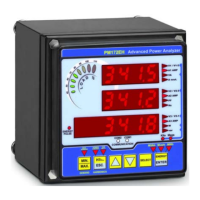14
Profile Data Log File
Data log file #8 can be configured for a daily profile log of the energy usage and maximum
demand registers. A profile log file is organized as a multi-section file that has a separate
section for each energy and maximum demand register. A file record stores the summary
data (total of all tariffs) and all tariff data for each configured Summary/TOU register. See
Section 3.10 for information on the file record structure.
The number of sections is taken automatically from the Summary/TOU Registers setup.
Since each Summary/TOU energy register has a shadow maximum demand register, the
number of sections in the file can be twice the number of the allocated Summary/TOU
registers. Always configure the Summary/TOU registers before you allocate memory for
your profile log file.
New records are added to the file automatically every day at midnight. You can review the
list of parameters that are recorded to the file through the Data log #8 setup. It is preset
automatically by the meter and shows the recorded data for the first file section, which
represents the first configured energy usage register.
Waveform Log Files
Waveform log files are organized as multi-section files that store data for each recording
channel in a separate section. A waveform log file can record 6 AC channels simultaneously:
three voltage and three current waveforms. The number of sections in a file, or channels
that a file can store, is defined when you set up the file. The channels that a file will record
are selected in the waveform log setup. All selected channels are recorded in successive file
sections.
A waveform file has a single read pointer for all sections, so that data from all channels of a
single record can be read together without repositioning the file pointer. When you point to
a particular file record, data from all sections related to the same event are all available for
a read. Moreover, the PM172 takes all channel data for the currently accessed record to a
separate buffer, so that even when the record is overwritten at the time of reading, you are
still prevented from receiving partially updated data.
A single waveform record for a channel can contain up to 512 points of the sampled input
signal. Refer to the line frequency field in the channel header record to correctly set up the
time scale for the waveforms.
If a waveform log is configured to record more samples per event than a single record can
hold, the waveform recorder will store as many records per event as required to record the
entire event. All waveform records related to the event are merged in a series and have the
same series number, so that they can be plotted together. Each record within a series has a
unique serial number that allows tracking the sequence of records in a series. A single
waveform series can hold up to 81,920 points (2,560 cycles at a rate of 32 samples per
cycle) of a sampled AC signal.
2.9.2 File Transfers
File transfer protocol provides both data transfer and information services. File transfer is
performed through blocks of registers separate for each file and file section. File transfer
control registers allow changing the file or section position in order to point to the desired
record.
The information service uses separate status/control registers for each file. The extended
file information is available including current file pointers’ positions, the number of records
in the file, allocated file size, and more.
See Section 3.9 File Transfer Registers for information on register locations.
Common File Transfer
Log files can be read either in a sequence record-by-record, or in a random order. Each
read request fills the corresponding register block with the data of the record pointed to by
the file (or section) read pointer. If you want to begin reading a file from a particular
record, which sequence number is known, you can change the pointer position by writing
the desired sequence number into the file transfer control register. If you want to read a file
from the beginning, you can simply write a corresponding command to the file command

